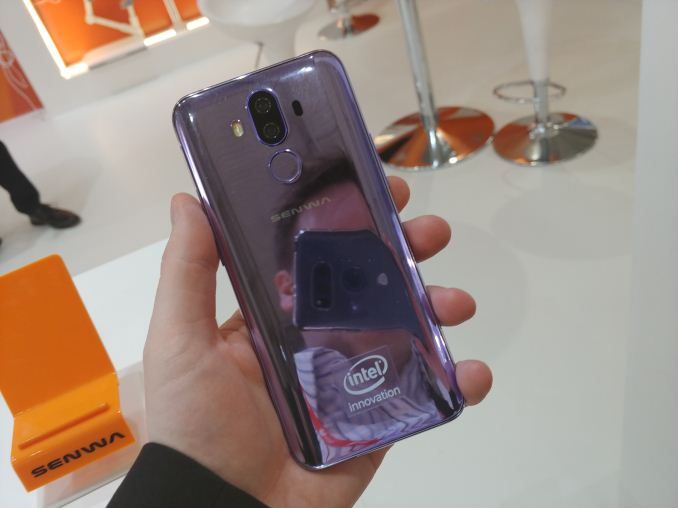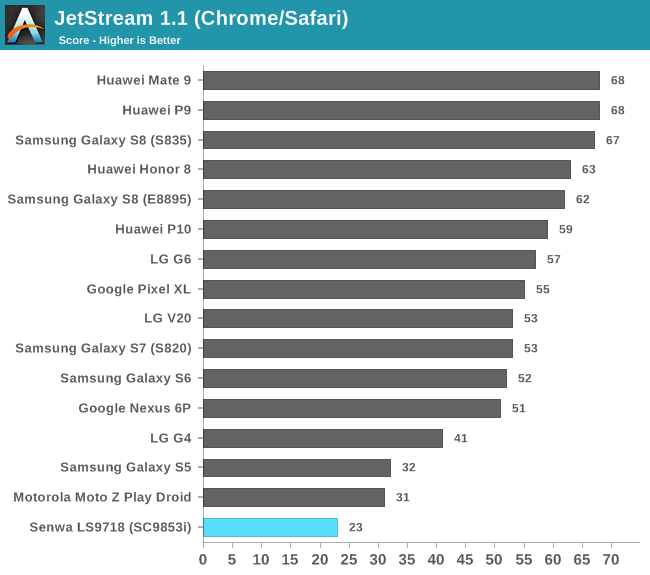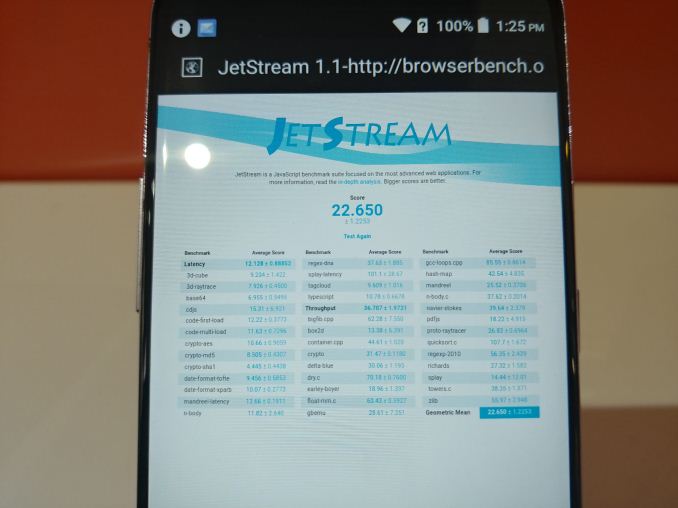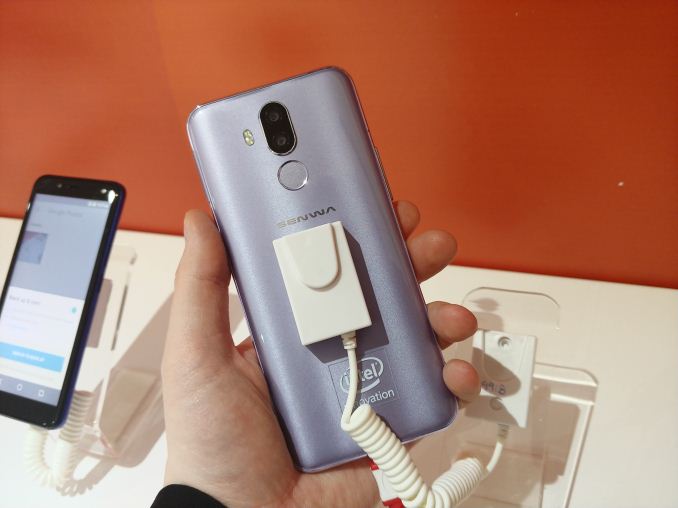Intel’s Last Atom in Smartphones: A 2018 Benchmark
by Ian Cutress on March 28, 2018 1:00 PM EST- Posted in
- Smartphones
- Intel
- Atom
- x86
- SoCs
- Spreadtrum
- Senwa
- SC9853i

Intel's push into smartphones over the last 10 years has been well documented, as well as the subsequent downfall after its Broxton smartphone SoCs were cancelled in April 2016. This was not the ‘end’ for Atom in smartphones: an agreement between Intel and Spreadtrum, a low-end SoC vendor based in Asia, kept Intel SoCs going into smartphones for the low-cost market. These chips contained Intel Atom x86 cores, graphics, Spreadtrum modems, and were built in Intel’s fabs.
The two chips to come out of the agreement so far were the SC9861G-IA in 2017, followed by the SC9853i at the end of last year. These chips have most found themselves in Senwa phones, specifically the LS9718 and LS9918 that were launched at Mobile World Congress this year, and are in devices primarily marketed to Latin America and Africa.
The Spreadtrum SC9853i, the latest SoC to come out of the agreement, is actually the lower end unit. It uses eight Intel Airmont cores at 1.8 GHz, a dual core Arm Mali-T820 GPU (down from PowerVR), a 1080p video engine (down from 4K), and a maximum supported camera resolution of 16MP. The modem inside is suitable for up to 4G Cat 7 / 300 Mbps download.
We managed to get hold of the Senwa LS9718 at the show, at the Senwa booth which had a big Intel logo. The booth was fairly devoid of people, or at least, those that were there were not actively engaging with the devices. I only managed to start to have a look around before being pounced on by a Senwa representative from Latin America. He didn’t seem to understand much about what I was doing there as press, and I couldn’t get any more information beyond ‘these are Intel phones’ out of him, but he was happy to stand and watch (at a distance of 6 inches) while I ran a benchmark.
The Senwa LS9718 as a phone is a typical super-midrange phone, with a 5.7-inch HD+ IPS screen in an 18:9 format, with 3 GB DRAM and 32 GB storage, and a battery of 3000 mAh. It felt reasonable to hold, it had a dual camera (16MP + 8MP), a fingerprint sensor, and actually kind of felt like an old Huawei phone to be honest. According to Senwa’s press releases, there was also the LS9918 on the stand featuring the same SoC, but with a more premium 5.99-inch HD+ IPS screen.
The goal of looking at the device was to actually see what I could get out of the SoC underneath. Intel cores in smartphones are, at this point, a relative novelty. It still relies on Android to be compiled for x86 for example, as well as the intricacies of graphics interconnect and all the usual terminology with Arm based-devices but done in the context of Intel’s large x86 mantra.
So here is the one result I managed to get: A score of 22.65 in Jetstream, running on the native browser. The test took around 15-20 minutes to complete, so I was almost pushing my luck if I had asked to download PCMark or something, especially with the Senwa rep basically breathing down my neck. To put that into context with our benchmark data:

It is worth noting that the Senwa device was using its native browser, which will lead to some variation. During MWC we also played a bit with the ASUS Zenfone 5, with its Snapdragon 636, an octa-core Kryo 260. That unit scored 45.34 using Chrome in regular mode, and 54.13 in CPU boost mode. Even compared to the results in the graph above, the performance puts the device well below the LG G4, the Samsung Galaxy S5. The Moto Z Play Droid is a Snapdragon 625, an octa-core A53 configuration up to 2.0 GHz, showing that the Atom cores just cannot keep up.

For detailed numbers, click to see the full resolution
Also worth mentioning is that the device started to get very warm to touch. Not uncomfortably so, but the combination of workload and heat soak was noticeable, especially over the 15 minutes it took for the test to run. For a javascript test like JetStream, I really would not expect a device to heat up as much as it did.
Funnily enough, in between MWC and today, Intel and Spreadtrum have agreed to extend their SoC alliance. The two companies are set to work together to develop SoCs integrating Intel’s 5G modems for deployment by the end of 2019. The difference here is that Spreadtrum plan to use Arm CPU cores, rather than Intel x86 cores. As a result, the SC9853i might be the last smartphone SoC with an Atom inside. So despite the new launches of devices from companies like Senwa, it is a rather meagre ending to a smartphone processor line that has been on life support for a while. This deal is also odd, given that Spreadtrum normally deals in the low-end SoC space, while 5G will be a premium addition to begin - either Intel is targeting 5G at the low-end as well, or Spreadtrum is gearing up for a high-end SoC, built on Intel's 14nm.
Sources: The Linley Group, PR Newswire












56 Comments
View All Comments
peevee - Tuesday, April 3, 2018 - link
I wonder how much of it is JIT translation of ARM code into x86 code vs natively compiled/optimized x86 code.HStewart - Wednesday, March 28, 2018 - link
The Atom is not true test of Intel's x86 cores - I put it on performance levels of older core 2 laptops from 10 years ago or so. It's technology has lead way into some higher performance chips like the Core M and also the forthcoming 9805g in the Dell XPS 15 2in1. It also include 16 core and possible more Server based chips aim with low power in mind.Also just including Jetstream benchmark is not to realistic comparison. This test should not be used as ARM vs x86 comparison.
Wilco1 - Monday, April 2, 2018 - link
Actually it's yet another good example why x86 is not suitable for anything low power. Atom has always been too slow or too power hungry compared to Arm cores.mode_13h - Monday, April 2, 2018 - link
I fear you're right, but it should be noted they're comparing an old architecture from 2013 against more modern ARM cores. A more fair comparison would be Goldmont or Goldmont+ (couldn't they find another mont?).Wilco1 - Saturday, April 7, 2018 - link
This was the only one that was reasonably power efficient - if this had been released 4 years ago it may not have looked so slow. Goldmont(+) is faster indeed but uses a lot more power - there was a good reason the mobile version was cancelled.nobodyblog - Wednesday, March 28, 2018 - link
That's no secret that Intel's Atom chips are not good. They are designed to run Android, but they are NOT best in it, too. Qualcomm are much better, even its mid tier. Totally, Android is optimized for ARM, too.Intel is best in laptop and desktop, not in mobile. But they have some advantages like mobility quality of Intel is better Perhaps. On paper things are different, though. ARM SOC is so good on paper, but, in action, I see them being normally good and CAN do the job, just like the atom that is not very optimized thing. I don't mind the benchmarks. I may see, but they are okay as long as it is not called a performance bug which makes problem in action. I also want better battery life rather better performance only....
Thanks!
Samus - Wednesday, March 28, 2018 - link
The real problem for Android devices (and Chromebooks for that matter) is the lack of optimization for x86. Atom CPU's are totally usable on Windows devices where the kernel is built specifically with Intel x86 in mind, not a recompilation retrofit lacking all sorts of optimizations like the Android kernel.Billy Tallis - Wednesday, March 28, 2018 - link
Android and Chromebook devices use the Linux kernel, which has always been developed with x86 support and optimization as the top priority. There might be some Atom-specific platform features that differ from PC architecture where Intel hasn't contributed drivers that are as good as the ARM counterparts, but its more likely that the Atom hardware is simply inferior to a good ARM SoC in those respects.peevee - Tuesday, April 3, 2018 - link
"Android and Chromebook devices use the Linux kernel, which has always been developed with x86 support and optimization as the top priority."Which has little to nothing to do with Javascript-in-some-unknown-browser tests.
Wilco1 - Saturday, April 7, 2018 - link
x86 has really good JavaScript engines. Atom is simply really slow compared to modern Arm CPUs.